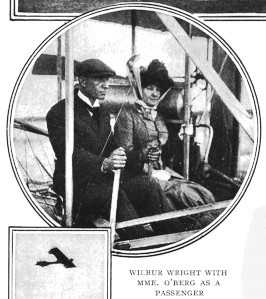Early Women Fliers
Today, we meet the first women pilots. The University of Houston's College of Engineering presents this series about the machines that make our civilization run, and the people whose ingenuity created them.
New technologies make good ports of entry for disenfranchised people. Black technologists started making their mark in telegraphy and electric lighting during the 1880's. The peer structures weren't established. There was no one to wall them out.
So it was for women in the new technologies of flight. Women took up ballooning right from its origins in the 1780s. And the hobble skirt was invented in 1908 when a French fashion designer saw the mincing steps of a Mrs. Hart Berg leaving Wilbur Wright's airplane in France. She was the first American woman to take to the air, and she'd tied a rope around the bottom of her skirt to keep it from blowing in the wind.
The first American woman piloted a plane two years later. Blanche Scott had managed to get into Glen Curtiss's new flying school. Curtiss didn't like the idea of women flying, and he'd blocked the throttle on her plane so it would only taxi. Blanche somehow managed to override the block and get herself 40 feet into the air. Two weeks later, one Bessica Raiche really soloed, but she eventually gave up flying to become a doctor.
Julia Clark was the first woman to die in a crash. She learned to fly in 1911 and died practicing for an exhibition two years later. Harriet Quimby was the first American woman licensed to fly, in 1912. A year later she was the first woman to fly the English Channel. She was a stunning beauty and a natural public figure. But that same year she was flying an overweight passenger in Boston. He lurched in his seat, and the airplane went out of control. They both fell out and were killed, while the airplane somehow righted itself and landed safely.
Women were amassing firsts and setting records as the clouds of WW-I gathered. Flight was helping to redefine the role of women. Now women wanted a piece of the action as it became clear that airplanes would play a role in the war. Then the wall went up.
The military was violently opposed to involving women in war. The woman who got closest to combat was Katherine Stinson -- sister of the famous airplane builder Eddie Stinson. First she trained Allied pilots at her own flying school. Then she went to France as an ambulance driver, where she did some flying for the Red Cross. She was a superb pilot who'd already set several flight endurance records before she went to France.
But war reasserts the male principle. By 1918 women had lost much of the ground they'd gained -- and not only in flight. Yet women had been right there, on the ground floor of flight, with remarkable courage, determination, inventiveness, and, of course -- natural ability.
I'm John Lienhard, at the University of Houston, where we're interested in the way inventive minds work.
(Theme music)
Oakes, C.M., United States Women in Aviation through World War I. Washington, D.C.: Smithsonian Institution Press, 1985.
For more on Harriet Quimby, see the following: http://en.wikipedia.org/wiki/Harriet_Quimby

(From the 1910 Cosmopolitan Magazine)
Wilbur Wright with Mrs. Hart Berg